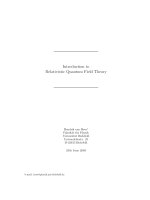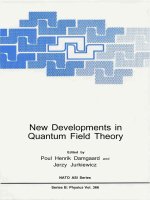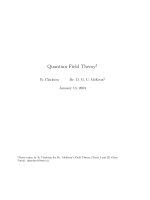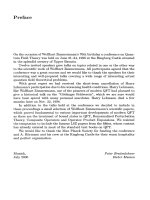- Trang chủ >>
- Khoa Học Tự Nhiên >>
- Vật lý
Quantum field theory demystified
Bạn đang xem bản rút gọn của tài liệu. Xem và tải ngay bản đầy đủ của tài liệu tại đây (3.69 MB, 318 trang )
Quantum Field
Theory Demystified
www.pdfgrip.com
Demystified Series
Accounting Demystified
Advanced Calculus Demystified
Advanced Physics Demystified
Advanced Statistics Demystified
Algebra Demystified
Alternative Energy Demystified
Anatomy Demystified
asp.net 2.0 Demystified
Astronomy Demystified
Audio Demystified
Biology Demystified
Biotechnology Demystified
Business Calculus Demystified
Business Math Demystified
Business Statistics Demystified
C++ Demystified
Calculus Demystified
Chemistry Demystified
Circuit Analysis Demystified
College Algebra Demystified
Corporate Finance Demystified
Data Structures Demystified
Databases Demystified
Diabetes Demystified
Differential Equations Demystified
Digital Electronics Demystified
Earth Science Demystified
Electricity Demystified
Electronics Demystified
Engineering Statistics Demystified
Environmental Science Demystified
Everyday Math Demystified
Fertility Demystified
Financial Planning Demystified
Forensics Demystified
French Demystified
Genetics Demystified
Geometry Demystified
German Demystified
Global Warming and Climate Change Demystified
Hedge Funds Demystified
Home Networking Demystified
Investing Demystified
Italian Demystified
Java Demystified
JavaScript Demystified
Lean Six Sigma Demystified
Linear Algebra Demystified
Macroeconomics Demystified
Management Accounting Demystified
Math Proofs Demystified
Math Word Problems Demystified
MATLAB® Demystified
Medical Billing and Coding Demystified
Medical Terminology Demystified
Meteorology Demystified
Microbiology Demystified
Microeconomics Demystified
Nanotechnology Demystified
Nurse Management Demystified
OOP Demystified
Options Demystified
Organic Chemistry Demystified
Personal Computing Demystified
Pharmacology Demystified
Physics Demystified
Physiology Demystified
Pre-Algebra Demystified
Precalculus Demystified
Probability Demystified
Project Management Demystified
Psychology Demystified
Quality Management Demystified
Quantum Field Theory Demystified
Quantum Mechanics Demystified
Real Estate Math Demystified
Relativity Demystified
Robotics Demystified
Sales Management Demystified
Signals and Systems Demystified
Six Sigma Demystified
Spanish Demystified
SQL Demystified
Statics and Dynamics Demystified
Statistics Demystified
Technical Analysis Demystified
Technical Math Demystified
Trigonometry Demystified
UML Demystified
Visual Basic 2005 Demystified
Visual C# 2005 Demystified
Vitamins and Minerals Demystified
XML Demystified
www.pdfgrip.com
Quantum Field
Theory Demystified
David McMahon
New York Chicago San Francisco Lisbon London
Madrid Mexico City Milan New Delhi San Juan
Seoul Singapore Sydney Toronto
www.pdfgrip.com
Copyright © 2008 by The McGraw-Hill Companies, Inc. All rights reserved. Manufactured in the United States of America. Except
as permitted under the United States Copyright Act of 1976, no part of this publication may be reproduced or distributed in any form
or by any means, or stored in a database or retrieval system, without the prior written permission of the publisher.
0-07-164352-4
The material in this eBook also appears in the print version of this title: 0-07-154382-1.
All trademarks are trademarks of their respective owners. Rather than put a trademark symbol after every occurrence of a
trademarked name, we use names in an editorial fashion only, and to the benefit of the trademark owner, with no intention of
infringement of the trademark. Where such designations appear in this book, they have been printed with initial caps.
McGraw-Hill eBooks are available at special quantity discounts to use as premiums and sales promotions, or for use in corporate
training programs. For more information, please contact George Hoare, Special Sales, at or (212)
904-4069.
TERMS OF USE
This is a copyrighted work and The McGraw-Hill Companies, Inc. (“McGraw-Hill”) and its licensors reserve all rights in and to the
work. Use of this work is subject to these terms. Except as permitted under the Copyright Act of 1976 and the right to store and
retrieve one copy of the work, you may not decompile, disassemble, reverse engineer, reproduce, modify, create derivative works
based upon, transmit, distribute, disseminate, sell, publish or sublicense the work or any part of it without McGraw-Hill’s prior
consent. You may use the work for your own noncommercial and personal use; any other use of the work is strictly prohibited. Your
right to use the work may be terminated if you fail to comply with these terms.
THE WORK IS PROVIDED “AS IS.” McGRAW-HILL AND ITS LICENSORS MAKE NO GUARANTEES OR WARRANTIES
AS TO THE ACCURACY, ADEQUACY OR COMPLETENESS OF OR RESULTS TO BE OBTAINED FROM USING THE
WORK, INCLUDING ANY INFORMATION THAT CAN BE ACCESSED THROUGH THE WORK VIA HYPERLINK OR
OTHERWISE, AND EXPRESSLY DISCLAIM ANY WARRANTY,EXPRESS OR IMPLIED, INCLUDING BUT NOT LIMITED
TO IMPLIED WARRANTIES OF MERCHANTABILITY OR FITNESS FOR A PARTICULAR PURPOSE. McGraw-Hill and its
licensors do not warrant or guarantee that the functions contained in the work will meet your requirements or that its
operation will be uninterrupted or error free. Neither McGraw-Hill nor its licensors shall be liable to you or anyone else for any
inaccuracy, error or omission, regardless of cause, in the work or for any damages resulting therefrom. McGraw-Hill has no
responsibility for the content of any information accessed through the work. Under no circumstances shall McGraw-Hill and/or its
licensors be liable for any indirect, incidental, special, punitive, consequential or similar damages that result from the use of or
inability to use the work, even if any of them has been advised of the possibility of such damages. This limitation of liability shall
apply to any claim or cause whatsoever whether such claim or cause arises in contract, tort or otherwise.
DOI: 10.1036/0071543821
www.pdfgrip.com
ABOUT THE AUTHOR
David McMahon works as a researcher at Sandia National Laboratories. He has
advanced degrees in physics and applied mathematics, and is the author of Quantum
Mechanics Demystified, Relativity Demystified, MATLAB® Demystified, and several
other successful books.
Copyright © 2008 by The McGraw-Hill Companies, Inc. Click here for terms of use.
www.pdfgrip.com
This page intentionally left blank
www.pdfgrip.com
CONTENTS AT A GLANCE
CHAPTER 1
Particle Physics and Special Relativity
CHAPTER 2
Lagrangian Field Theory
23
CHAPTER 3
An Introduction to Group Theory
49
CHAPTER 4
Discrete Symmetries and Quantum Numbers
71
CHAPTER 5
The Dirac Equation
85
CHAPTER 6
Scalar Fields
109
CHAPTER 7
The Feynman Rules
139
CHAPTER 8
Quantum Electrodynamics
163
CHAPTER 9
Spontaneous Symmetry Breaking and
the Higgs Mechanism
187
CHAPTER 10
Electroweak Theory
209
CHAPTER 11
Path Integrals
233
CHAPTER 12
Supersymmetry
245
Final Exam
263
Solutions to Quizzes and Final Exam
281
References
289
Index
291
www.pdfgrip.com
1
This page intentionally left blank
www.pdfgrip.com
For more information about this title, click here
CONTENTS
Preface
xv
CHAPTER 1
Particle Physics and Special Relativity
Special Relativity
A Quick Overview of Particle Physics
Elementary Particles
The Higgs Mechanism
Grand Unification
Supersymmetry
String Theory
Summary
Quiz
1
5
12
14
18
18
19
19
20
20
CHAPTER 2
Lagrangian Field Theory
Basic Lagrangian Mechanics
The Action and the Equations of Motion
Canonical Momentum and the Hamiltonian
Lagrangian Field Theory
Symmetries and Conservation Laws
Conserved Currents
The Electromagnetic Field
Gauge Transformations
Summary
Quiz
23
23
26
29
30
35
38
39
43
47
47
www.pdfgrip.com
x
Quantum Field Theory Demystified
CHAPTER 3
An Introduction to Group Theory
Representation of the Group
Group Parameters
Lie Groups
The Rotation Group
Representing Rotations
SO(N)
Unitary Groups
Casimir Operators
Summary
Quiz
49
50
52
52
54
55
58
62
67
68
68
CHAPTER 4
Discrete Symmetries and Quantum Numbers
Additive and Multiplicative Quantum Numbers
Parity
Charge Conjugation
CP Violation
The CPT Theorem
Summary
Quiz
71
71
72
76
78
80
82
83
CHAPTER 5
The Dirac Equation
The Classical Dirac Field
Adding Quantum Theory
The Form of the Dirac Matrices
Some Tedious Properties of the
Dirac Matrices
Adjoint Spinors and Transformation Properties
Slash Notation
Solutions of the Dirac Equation
Free Space Solutions
Boosts, Rotations, and Helicity
Weyl Spinors
Summary
Quiz
85
85
87
89
www.pdfgrip.com
91
94
95
95
99
103
104
107
108
xi
Contents
CHAPTER 6
Scalar Fields
Arriving at the Klein-Gordon Equation
Reinterpreting the Field
Field Quantization of Scalar Fields
States in Quantum Field Theory
Positive and Negative Frequency
Decomposition
Number Operators
Normalization of the States
Bose-Einstein Statistics
Normal and Time-Ordered Products
The Complex Scalar Field
Summary
Quiz
109
110
117
117
127
CHAPTER 7
The Feynman Rules
The Interaction Picture
Perturbation Theory
Basics of the Feynman Rules
Calculating Amplitudes
Steps to Construct an Amplitude
Rates of Decay and Lifetimes
Summary
Quiz
139
141
143
146
151
153
160
160
160
CHAPTER 8
Quantum Electrodynamics
Reviewing Classical Electrodynamics Again
The Quantized Electromagnetic Field
Gauge Invariance and QED
Feynman Rules for QED
Summary
Quiz
163
165
168
170
173
185
185
CHAPTER 9
Spontaneous Symmetry Breaking and
the Higgs Mechanism
Symmetry Breaking in Field Theory
187
189
www.pdfgrip.com
128
128
130
131
134
135
137
137
xii
Quantum Field Theory Demystified
Mass Terms in the Lagrangian
Aside on Units
Spontaneous Symmetry Breaking and Mass
Lagrangians with Multiple Particles
The Higgs Mechanism
Summary
Quiz
192
195
196
199
202
207
207
Electroweak Theory
Right- and Left-Handed Spinors
A Massless Dirac Lagrangian
Leptonic Fields of the Electroweak Interactions
Charges of the Electroweak Interaction
Unitary Transformations and the Gauge Fields
of the Theory
Weak Mixing or Weinberg Angle
Symmetry Breaking
Giving Mass to the Lepton Fields
Gauge Masses
Summary
Quiz
209
210
211
212
213
CHAPTER 11
Path Integrals
Gaussian Integrals
Basic Path Integrals
Summary
Quiz
233
233
238
242
243
CHAPTER 12
Supersymmetry
Basic Overview of Supersymmetry
Supercharge
Supersymmetric Quantum Mechanics
The Simplified Wess-Zumino Model
A Simple SUSY Lagrangian
Summary
Quiz
245
246
247
249
253
254
260
260
CHAPTER 10
www.pdfgrip.com
215
219
220
222
224
231
231
xiii
Contents
Final Exam
263
Solutions to Quizzes and Final Exam
281
References
289
Index
291
www.pdfgrip.com
This page intentionally left blank
www.pdfgrip.com
PREFACE
Quantum field theory is the union of Einstein’s special relativity and quantum
mechanics. It forms the foundation of what scientists call the standard model, which
is a theoretical framework that describes all known particles and interactions with
the exception of gravity. There is no time like the present to learn it—the Large
Hadron Collider (LHC) being constructed in Europe will test the final pieces of the
standard model (the Higgs mechanism) and look for physics beyond the standard
model. In addition quantum field theory forms the theoretical underpinnings of string
theory, currently the best candidate for unifying all known particles and forces into
a single theoretical framework.
Quantum field theory is also one of the most difficult subjects in science. This
book aims to open the door to quantum field theory to as many interested people as
possible by providing a simplified presentation of the subject. This book is useful
as a supplement in the classroom or as a tool for self-study, but be forewarned that
the book includes the math that comes along with the subject.
By design, this book is not thorough or complete, and it might even be considered
by some “experts” to be shallow or filled with tedious calculations. But this book is
not written for the experts or for brilliant graduate students at the top of the class, it
is written for those who find the subject difficult or impossible. Certain aspects of
quantum field theory have been selected to introduce new people to the subject, or
to help refresh those who have been away from physics.
After completing this book, you will find that studying other quantum field
theory books will be easier. You can master quantum field theory by tackling the
reference list in the back of this book, which includes a list of textbooks used in the
development of this one. Frankly, while all of those books are very good and make
fine references, most of them are hard to read. In fact many quantum field theory
books are impossible to read. My recommendation is to work through this book
first, and then tackle Quantum Field Theory in a Nutshell by Anthony Zee. Different
than all other books on the subject, it’s very readable and is packed with great
Copyright © 2008 by The McGraw-Hill Companies, Inc. Click here for terms of use.
www.pdfgrip.com
xvi
Quantum Field Theory Demystified
physical insight. After you’ve gone through that book, if you are looking for
mastery or deep understanding you will be well equipped to tackle the other books
on the list.
Unfortunately, learning quantum field theory entails some background in physics
and math. The bottom line is, I assume you have it. The background I am expecting
includes quantum mechanics, some basic special relativity, some exposure to
electromagnetics and Maxwell’s equations, calculus, linear algebra, and differential
equations. If you lack this background do some studying in these subjects and then
give this book a try.
Now let’s forge ahead and start learning quantum field theory.
David McMahon
www.pdfgrip.com
Quantum Field
Theory Demystified
www.pdfgrip.com
This page intentionally left blank
www.pdfgrip.com
CHAPTER 1
Particle Physics
and
Special Relativity
Quantum field theory is a theoretical framework that combines quantum mechanics
and special relativity. Generally speaking, quantum mechanics is a theory that
describes the behavior of small systems, such as atoms and individual electrons.
Special relativity is the study of high energy physics, that is, the motion of
particles and systems at velocities near the speed of light (but without gravity).
What follows is an introductory discussion to give you a flavor of what quantum
field theory is like. We will explore each concept in more detail in the following
chapters.
There are three key ideas we want to recall from quantum mechanics, the
first being that physical observables are mathematical operators in the theory.
Copyright © 2008 by The McGraw-Hill Companies, Inc. Click here for terms of use.
www.pdfgrip.com
2
Quantum Field Theory Demystified
For instance, the Hamiltonian (i.e., the energy) of a simple harmonic oscillator is the
operator
1⎞
⎛
Hˆ = ω ⎜ aˆ † aˆ + ⎟
⎝
2⎠
where aˆ †, aˆ are the creation and annihilation operators, and is Planck’s constant.
The second key idea you should remember from quantum mechanics is the
uncertainty principle. The uncertainty relation between the position operator xˆ and
the momentum operator pˆ is
Δxˆ Δpˆ ≥
2
(1.1)
There is also an uncertainty relation between energy and time.
ΔE Δt ≥
2
(1.2)
When considering the uncertainty relation between energy and time, it’s important
to remember that time is only a parameter in nonrelativistic quantum mechanics,
not an operator.
The final key idea to recall from quantum mechanics is the commutation
relations. In particular,
ˆˆ − px
ˆˆ =i
[ xˆ, pˆ ] = xp
Now let’s turn to special relativity. We can jump right to Einstein’s famous equation
that every lay person knows something about, in order to see how special relativity
is going to impact quantum theory. This is the equation that relates energy to mass.
E = mc 2
(1.3)
What should you take away from this equation? The thing to notice is that if there
is enough energy—that is, enough energy proportional to a given particle’s mass as
described by Eq. (1.3)—then we can “create” the particle. Due to conservation laws,
we actually need twice the particle’s mass, so that we can create a particle and its
antiparticle. So in high energy processes,
• Particle number is not fixed.
• The types of particles present are not fixed.
These two facts are in direct conflict with nonrelativistic quantum mechanics. In
nonrelativistic quantum mechanics, we describe the dynamics of a system with the
www.pdfgrip.com
CHAPTER 1
Particle Physics and Special Relativity
3
Schrödinger equation, which for a particle moving in one dimension with a potential
V is
∂ψ
∂ 2ψ
+ Vψ = i
2
∂t
2m ∂x
2
−
(1.4)
We can extend this formalism to treat the case when several particles are present.
However, the number and types of particles are absolutely fixed. The Schrödinger
equation cannot in any shape or form handle changing particle number or new types
of particles appearing and disappearing as relativity allows.
In fact, there is no wave equation of the type we are used to from nonrelativistic
quantum mechanics that is truly compatible with both relativity and quantum
theory. Early attempts to merge quantum mechanics and special relativity focused
on generating a relativistic version of the Schrödinger equation. In fact,
Schrödinger himself derived a relativistic equation prior to coming up with the
wave equation he is now famous for. The equation he derived, which was later
discovered independently by Klein and Gordon (and is now known as the
Klein-Gordon equation) is
1 ∂ 2ϕ ∂ 2ϕ m 2 c 2
= 2 ϕ
−
c 2 ∂t 2 ∂x 2
We will have more to say about this equation in future chapters. Schrödinger
discarded it because it gave the wrong fine structure for the hydrogen atom. It is
also plagued by an unwanted feature—it appears to give negative probabilities,
something that obviously contradicts the spirit of quantum mechanics. This equation
also has a funny feature—it allows negative energy states.
The next attempt at a relativistic quantum mechanics was made by Dirac. His
famous equation is
i
∂ψ
= − i cα ⋅ ∇ψ + β mc 2ψ
∂t
Here, α and b are actually matrices. This equation, which we will examine in
detail in later chapters, resolves some of the problems of the Klein-Gordon equation
but also allows for negative energy states.
As we will emphasize later, part of the problem with these relativistic wave
equations is in their interpretation. We move forward into a quantum theory of
fields by changing how we look at things. In particular, in order to be truly
compatible with special relativity we need to discard the notion that j and y in the
www.pdfgrip.com
4
Quantum Field Theory Demystified
Klein-Gordon and Dirac equations, respectively describe single particle states. In
their place, we propose the following new ideas:
• The wave functions ϕ and ψ are not wave functions at all, instead they are
fields.
• The fields are operators that can create new particles and destroy particles.
Since we have promoted the fields to the status of operators, they must satisfy
commutation relations. We will see later that we make a transition of the type
[ xˆ , pˆ ] → [ϕˆ ( x, t ), πˆ ( y, t )]
Here, πˆ ( y, t ) is another field that plays the role of momentum in quantum field
theory. Since we are transitioning to the continuum, the commutation relation will
be of the form
[ϕˆ ( x, t ), πˆ ( y, t )] = i
δ ( x − y)
where x and y are two points in space. This type of relation holds within it the
notion of causality so important in special relativity—if two fields are spatially
separated they cannot affect one another.
With fields promoted to operators, you might wonder what happens to the ordinary
operators of quantum mechanics. There is one important change you should make
sure to keep in mind. In quantum mechanics, position xˆ is an operator while time t
is just a parameter. In relativity, since time and position are on a similar footing, we
might expect that in relativistic quantum mechanics we would also put time and
space on a similar footing. This could mean promoting time to an operator tˆ. This is
not what is done in ordinary quantum field theory, where we take the opposite
direction—and demote position to a parameter x. So in quantum field theory,
• Fields ϕ and ψ are operators.
• They are parameterized by spacetime points (x, t).
• Position x and time t are just numbers that fix a point in spacetime—they
are not operators.
• Momentum continues to play a role as an operator.
In quantum field theory, we frequently use tools from classical mechanics to
deal with fields. Specifically, we often use the Lagrangian
L = T −V
www.pdfgrip.com
(1.5)
CHAPTER 1
Particle Physics and Special Relativity
5
The Lagrangian is important because symmetries (such as rotations) leave the form
of the Lagrangian invariant. The classical path taken by a particle is the one which
minimizes the action.
S = ∫ L dt
(1.6)
We will see how these methods are applied to fields in Chap. 2.
Special Relativity
The arena in which quantum field theory operates is the high energy domain of
special relativity. Therefore, brushing up on some basic concepts in special
relativity and familiarizing ourselves with some notation is important to gain some
understanding of quantum field theory.
Special relativity is based on two simple postulates. Simply stated, these are:
• The laws of physics are the same for all inertial observers.
• The speed of light c is a constant.
An inertial frame of reference is one for which Newton’s first law holds. In
special relativity, we characterize spacetime by an event, which is something that
happens at a particular time t and some spatial location (x, y, z). Also notice that the
speed of light c can serve in a role as a conversion factor, transforming time into
space and vice versa. Space and time therefore form a unified framework and we
denote coordinates by (ct, x, y, z).
One consequence of the second postulate is the invariance of the interval. In
special relativity, we measure distance in space and time together. Imagine a flash
of light emitted at the origin at t = 0. At some later time t the spherical wavefront
of the light can be described by
c2t 2 = x 2 + y2 + z 2
⇒ c2t 2 − x 2 − y2 − z 2 = 0
Since the speed of light is invariant, this equation must also hold for another
observer, who is measuring coordinates with respect to a frame we denote by
( ct ′, x ′, y ′, z ′ ). That is,
c2t ′ 2 − x ′ 2 − y′ 2 − z ′ 2 = 0
www.pdfgrip.com
Quantum Field Theory Demystified
6
It follows that
c2t 2 − x 2 − y2 − z 2 = c2t ′ 2 − x ′ 2 − y′ 2 − z ′ 2
Now, in ordinary space, the differential distance from the origin to some point
( x, y, z ) is given by
dr 2 = dx 2 + dy 2 + dz 2
We define an analogous concept in spacetime, called the interval. This is denoted
by ds 2 and is written as
ds 2 = c 2 dt 2 − dx 2 − dy 2 − dz 2
(1.7)
From Eq. (1.7) it follows that the interval is invariant. Consider two observers in
two different inertial frames. Although they measure different spatial coordinates
( x, y, z ) and ( x ′, y ′, z ′ ) and different time coordinates t and t ′ to label events, the
interval for each observer is the same, that is,
ds 2 = c 2 dt 2 − dx 2 − dy 2 − dz 2 = c 2 dt ′ 2 − dx ′ 2 − dy ′ 2 − dz ′ 2 = ds ′ 2
This is a consequence of the fact that the speed of light is the same for all inertial
observers.
It is convenient to introduce an object known as the metric. The metric can be
used to write down the coefficients of the differentials in the interval, which in this
case are just +/−1. The metric of special relativity (“flat space”) is given by
η μν
⎛1 0 0 0 ⎞
⎜ 0 −1 0 0 ⎟
⎟
=⎜
⎜ 0 0 −1 0 ⎟
⎜⎝ 0 0 0 −1⎟⎠
(1.8)
The metric has an inverse, which in this case turns out to be the same matrix. We
denote the inverse with lowered indices as
⎛1 0 0 0 ⎞
⎜ 0 −1 0 0 ⎟
⎟
ημν = ⎜
⎜ 0 0 −1 0 ⎟
⎜⎝ 0 0 0 −1⎟⎠
www.pdfgrip.com









